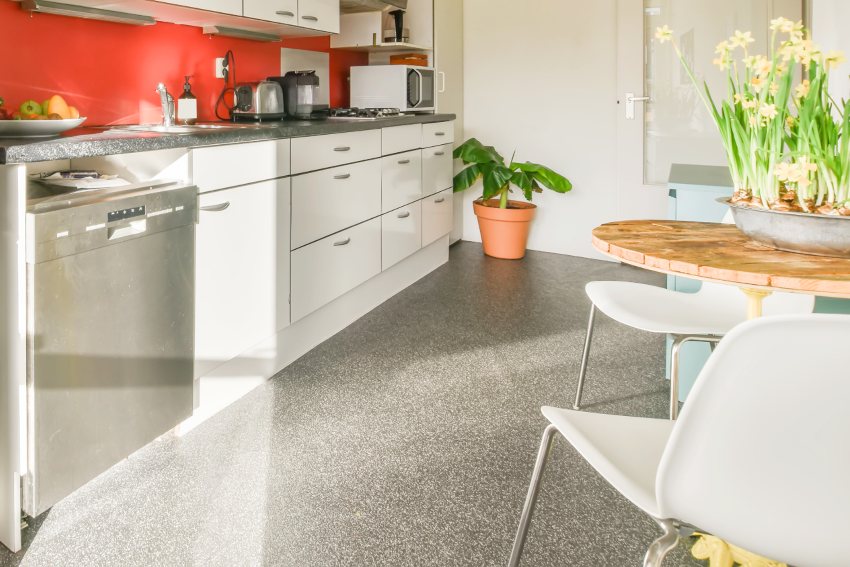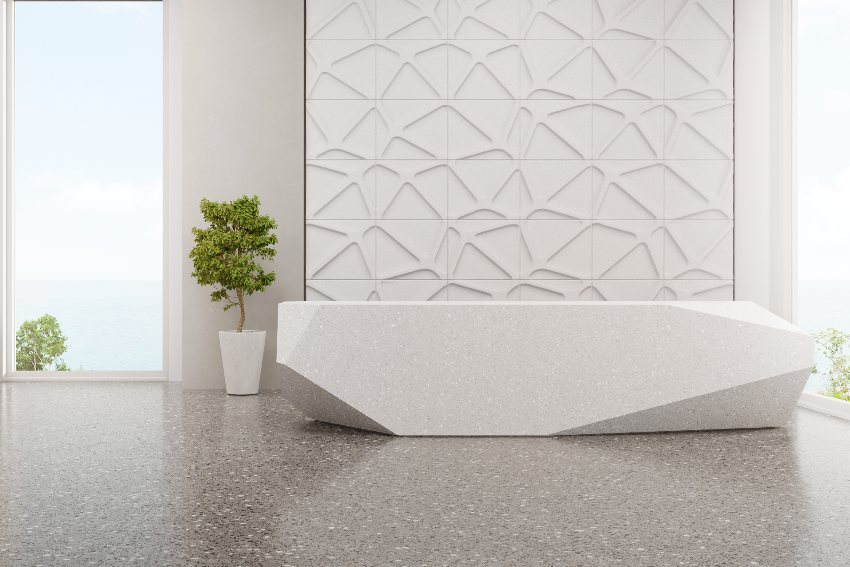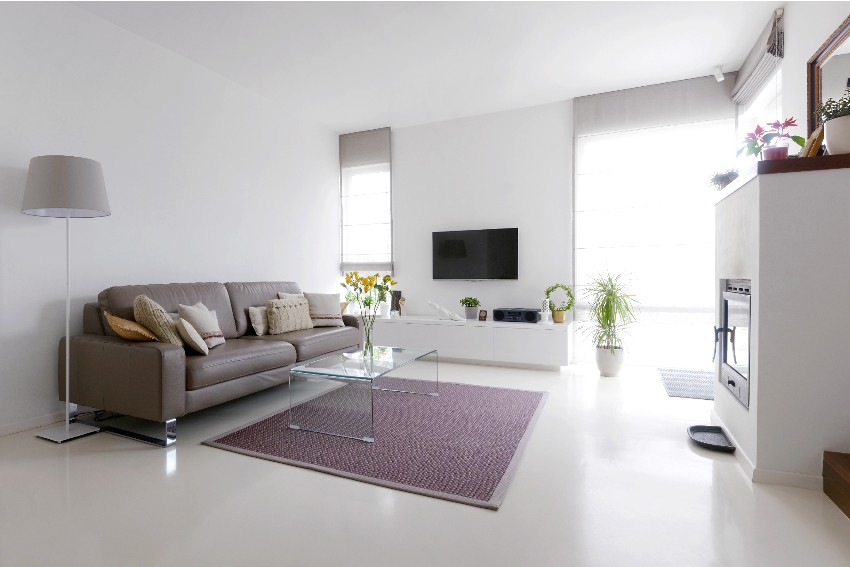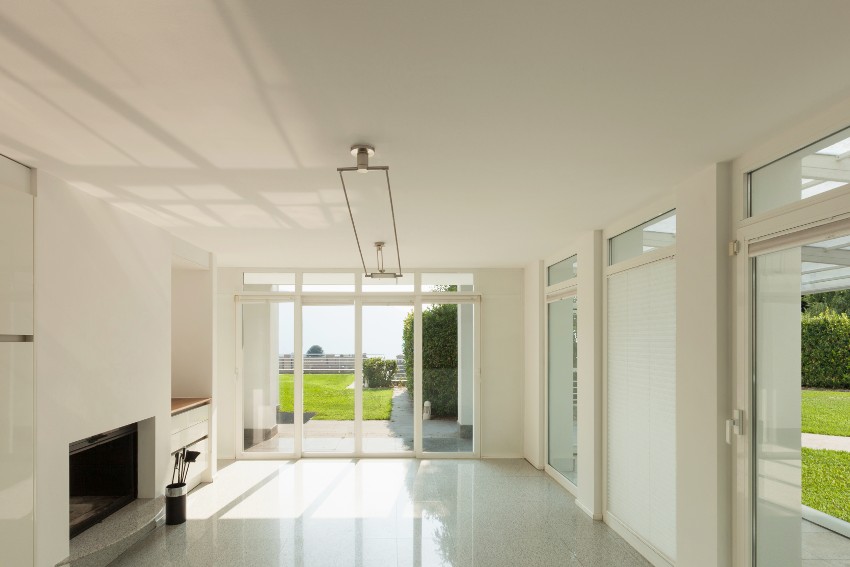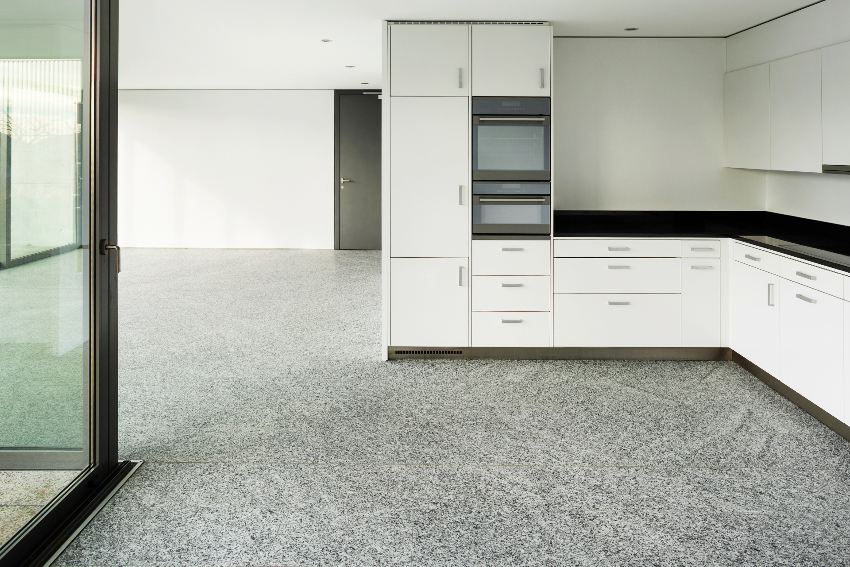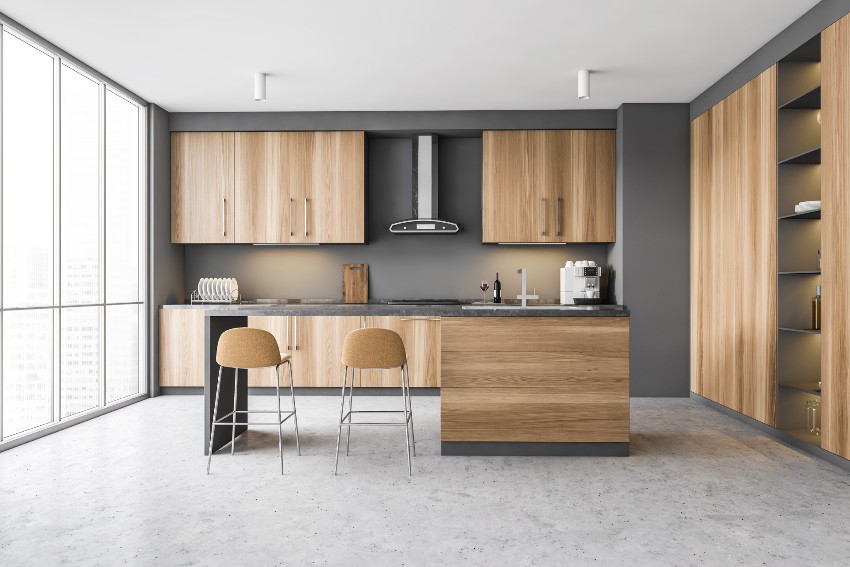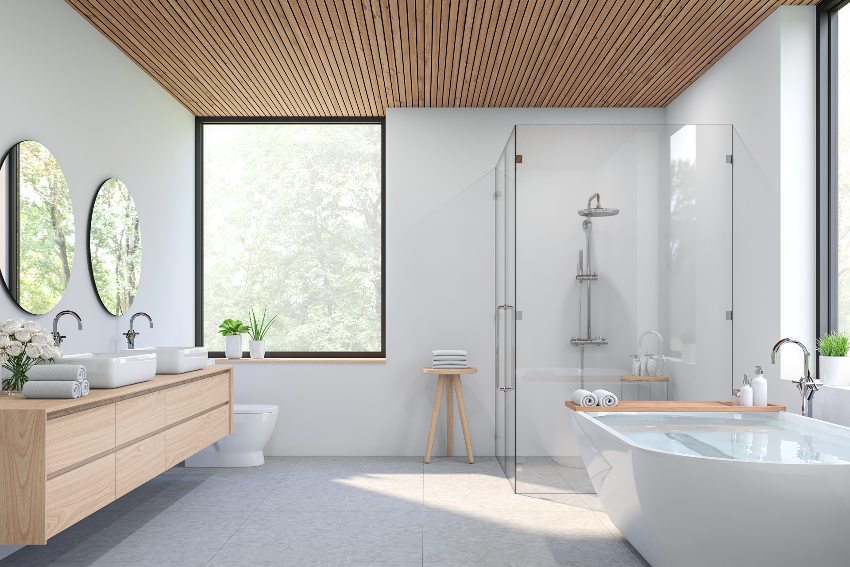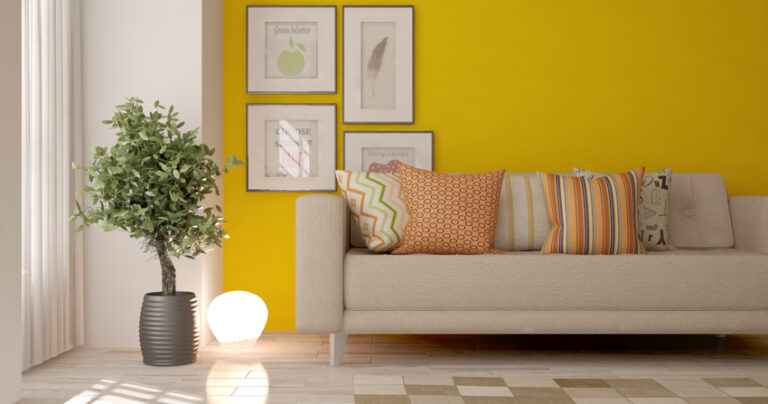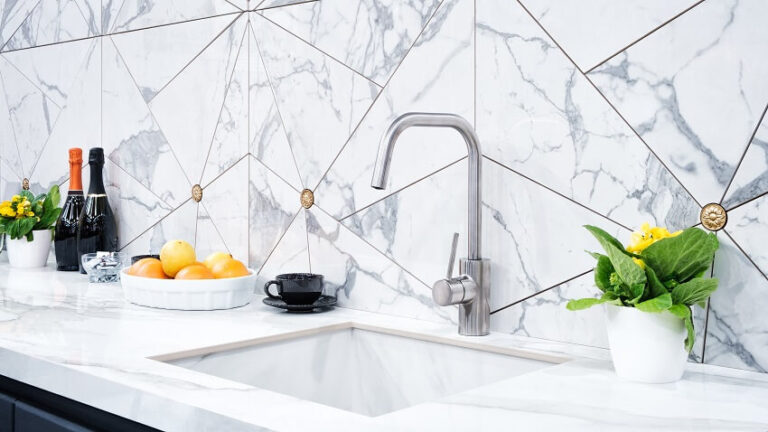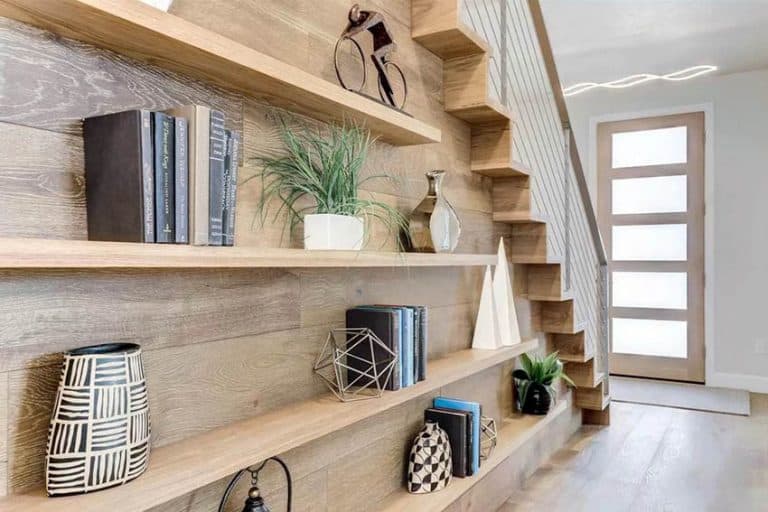Quartz Epoxy Floor (Coating Types & Pros and Cons)

Quartz epoxy floors are the aesthetic decorative variant of epoxy-resin floors. They’re highly attractive and durable, and the best part is that they can be used relatively anywhere.
Some of the most common places where quartz epoxy flooring reign supreme would be restaurants, manufacturing plants, kitchens, research labs, locker rooms and bathrooms, showrooms, schools, warehouses, healthcare facilities, and so much more. The sky’s the limit, really. If it needs a floor, a quartz epoxy floor would be fairly applicable.
If you’ve been wanting to get a quartz epoxy floor installed for quite some time but have some questions and gray areas about it, keep reading. Down below, we will tackle what it’s all about, what types of quartz epoxy floors are out there, and even the price ranges so that you may decide which one suits you best.
What Is Quartz Epoxy Flooring?
Basic epoxy flooring, in principle, is comprised of multiple coats or layers of epoxy. These layers are applied to a floor substrate with a thickness of a minimum of two millimeters. These layers of thermosetting resin are applied layer upon layer and are troweled and coated and then eventually poured onto the floor that they’re supposed to adhere to and become one with.
Epoxy quartz flooring is unique because its installation requires a resin body coating application over a base floor surface. This is oftentimes a bare concrete floor that is already primed and acts as a substrate.
This body coat of resin may be applied with just one layer, which is referred to as single broadcast, or can be applied in two layers or more which can also be referred to as double broadcast, and so on, as the layers tack on to each other.
It sounds pretty simplistic, and it would be understandable if you would think right off the bat that epoxy quartz flooring is just that. However, interestingly, there is a certain degree of versatility to it.
Quartz epoxy resin body manufacturers actually have a few options available. There are three basic resin body coats to choose from: plain epoxy, MMA or methyl methacrylate, and cementitious urethane or urethane concrete.
Epoxy flooring goes far beyond just aesthetics. It’s a highly strong and incredibly durable floor surface, which makes it so popular for industrial and commercial flooring uses. As a matter of fact, it can even be made more chemically resistant when applied with a polyaspartic topcoat on top of the main resin body coat.
Floor Coating Installation Steps
Using quartz epoxy floor coating is bringing your basic concrete floors to a whole new level. Decorative quartz is incorporated into the epoxy resin. This creates a floor surface area that’s highly attractive and durable.
It requires multiple steps for its installation, and depending on the installer, the process may vary every now and then. Still, the basic principles are pretty solid. And, of course, they are always worth the trouble of having them.
The first step is to prepare the bare concrete floor for it. – This is one of the most important steps in a quartz epoxy floor coating process. The floor substrates need to be properly prepared.
There shouldn’t be any dust, dirt, or other contaminants that may end up interfering with the epoxy’s adhesive properties. If it’s new concrete, it should go through the curing process of at least 30 days. See epoxy floor vs polished concrete design guide for more ideas.
This will ensure that the floor slab has no internal moisture that might go up to the surface and ruin the coating. The surface also needs to be rough enough, similar to a 60-grit sandpaper, in order for the epoxy actually to have something to grab onto.
Any cracks or holes in the concrete surface also need to be filled in ahead of time. This can be done with some concrete or putty, depending on what your main preferences are.
Next, you need to apply a base coat or some type of primer that will work well with quartz epoxy. – You can either go for the tinted option or the clear one.
This guarantees that the floor surface is prepared even more and that the epoxy will be able to tack onto it. This process is also great for sealing the air in the concrete so that it doesn’t gas out to the finished surface.
Throw in the quartz. Usually, these are quartz flakes. Throw handfuls of them onto the wet surface until it is covered according to your liking. Quartz is a fairly dense material. It will stay where you threw it, and it dropped on the floor.
Make it a point to throw it out mid-air so that it scatters accordingly instead of lumping handfuls of them directly on the floor. You can repeat this and make it as thick as you’d like. The thicker the quartz is, the heavier the duty of the floor will be.
And, of course, the finishing touch is a protective top coat. This will lock your quartz flakes in place, making sure it is smoothed out and isn’t porous. This also makes your overall floor surface fairly easy to finish. If you want to thin the surface out a bit, you can get this done by spreading it out with a heavy-duty squeegee.
Although they’re saying you should be able to walk on these floors in as early as 4 hours, we would actually recommend that you let your floors cure for a minimum of at least 2 to 3 days just to be on the safe side.
Colored Applications
Colored quartz epoxy flooring is very similar to the one just discussed above. The only difference is the use of a combination of colored quartz aggregates mixed in with an epoxy-based binder, of course. This delivers a quite colorful, artistic, yet highly durable floor.
It can usually come in multiple finishes, from smooth, to non-skid, to what they refer to as “the orange peel”, or a semi-smooth surface with multiple pinholes along the surface. They’re great for virtually any project you can think of, whether you’re restoring a space, constructing it from scratch, or doing basic renovations and redesigns.
Decorative Applications
Quartz, all on its own, is actually a colorless material. Decorative quartz, on the other hand, showcases the best details and the best macro-changes in the formulation of this mineral, and this is exactly what can be showcased on your floor’s surfaces.
Decorative quartz is installed in pretty much the same process as the colored quartz flake system, with the only difference being the type of quartz being displayed.
It showcases not only different colored materials but also different textures, from multicolored to smooth, semi-smooth, and even crystalline ones. The level of texture and dimensionality this brings to your floors is unlike any other you’ve ever seen. Another product similar to quartz epoxy is terrazzo flooring, which offers many of the same characteristics.
Quartz-Epoxy Flooring Pros And Cons
As great as epoxy quartz floors are, they do come with their veritable pros and cons. After all, no single flooring system is perfect. One thing that you can rest assured of, though, is that their advantages will always far outweigh their downsides for most if not all, applications.
For you to make an informed decision, here are the most significant pros and cons of quartz epoxy flooring to take note of:
Pros of Quartz Epoxy:
It’s economical – This material has a really low cost compared to other flooring options per square foot. Its low price range is its biggest strength. More than that, it has a no-fuss installation as well. It is a flooring option that can be directly installed on existing concrete.
There isn’t any need to get a separate floor system installed. Quartz epoxy is something that costs more compared to concrete polishing.
Although it costs more on the front end, what’s great about it is that when it eventually wears out, and you need to replace it, its replacement cost is much lower. There isn’t any need to prepare the concrete substrate you’d like it to adhere to.
Great resistance to damage – It’s tough and impressively resistant to many floor hazards such as oil, gas, cleaners, transmission fluids, and other harsh chemicals. Apart from the fact that it can be resistant to damage, they are also heat- and water-resistant.
This seamless flooring material is perfect for areas or functions that demand durability, such as workshops, laboratories, factories, retail stores, medical facilities, etc.
It enjoys a prolonged life span – One of the biggest selling points of this material is that it’s a low-cost yet durable solution to flooring needs – and it lasts. It all depends on the application as there can be various. Professional epoxy coatings can last anywhere from 7 to 20 years and upwards.
Those that are used in industrial settings have the lowest life spans because they are exposed to the harshest damages, heaviest loads, and the most abrasive of chemicals. However, those installed in the basements and other residential uses can easily last for decades.
They’re easily customizable – You’ll be able to achieve the precise look for the floors you want with this flooring material. The options are almost unlimited. You can come up with your very own effect.
You can opt for geometric patterns, flake details, logos, and more. This makes it very attractive not just for homes but for retail and shopping stores as well because they can incorporate their branding into it. This not only helps out with safety but also helps drum up some foot traffic, which can be really great for business at the end of the day.
Cons of Quartz Epoxy:
Moist environments may be a bit of an issue – Installing this material in areas that may have some issues with moisture, such as the basement, can cause some real problems. If the subfloor is moist or has moisture issues that come and go, the resin body coat may end up lifting off of the floor.
So, although it’s an economical flooring solution for the basement, for example, it may bring you more problems than solutions, especially if you don’t keep tabs on the moisture problems in the basement.
The slippery surface – These floors usually have topcoats that make them resistant to slips and skids. This makes the floor very safe to use, even when it’s wet.
However, without this very specific additive that addresses slippage, your floors can end up becoming a slippery hazard. They can be a danger to you and others when they’re wet, especially in the case of oil and chemical spills.
Can fade – Just like many materials, this floor application can fade when subjected to prolonged exposure to direct sunlight and UV rays. Choosing a quality product that includes UV inhibitors and choosing colors that are less prone to fading can help minimize its discoloration. Selecting earth tones and darker neutrals is a good choice if this is a concern.
Flooring Prices
Basic epoxy flooring can be quite inexpensive, and it is one of the main reasons why it’s so popular. It’s great at providing superior flooring quality. And in terms of long-term value and bang for buck value for your money, it is also pretty high up there.
Some factors can affect the pricing, from how many square feet your flooring project is to what grade of resin you’re actually using. A pretty ballpark range for this kind of flooring would be something as low as $3 per square foot to a maximum of $10 per square foot if you opted for a high-end resin body coat. Regardless, at the end of the day, it’s still a pretty good rate compared to other, more expensive flooring options.
Although fairly cheap on the front end, such material is not without faults, especially if you’re doing this in an industrial or commercial space. You may need to shut down for 2 to 3 days to get the best effect.
Technically speaking, resinous coating for floors can be walked on within 18 hours after being laid down, but there’s no guarantee that it’s been fully cured yet. It would be best to wait it out for 2-3 days.
This can have an economic impact on your business, but is something that’s necessary in order for you to be able to protect your business. Rushing it will end up costing you more money in the long run.
How Do You Clean A Quartz-Epoxy Floor?
So, let’s say you’re all set with this kind of flooring. You now have something truly beautiful. But on top of all this, you have a type of flooring that is resistant to spills, the heavy wear and tear of daily use, tire and skid marks, and so on and so much more.
You have something that’s durable and meant to last. But one thing that you should know is that there is periodic maintenance required for you to be able to maintain and prolong its life span as well as its durability. Here are some ways for you to keep your floors clean.
Use a mop – Mop your floors up with some mop that’s been soaked in some warm water and a cleaning product or solution of your choice. Always make sure that you clean your water at all times. Make sure that you use clean mop heads as well.
Everything else follows and falls into line. Make sure your pails or buckets, the brushes, and all of the other tools that you might be using while cleaning are clean. Go out of your way to rinse your mop often as well, preferably after each and every single use. This helps make sure that you aren’t spreading dirt across your floors.
For stubborn stains, use a degreaser – To amp it up a bit, try using a degreaser to clean your floors. It’s much safer than using solvents, cleaners that have toxic ingredients in them, or even bleaches.
A degreaser usually has a highly concentrated formula, and it can deeply degrease, clean, and deodorize without the use of harsh chemicals. Also, don’t let your disinfectants and other cleaners dry on your floor surface. This can alter the texture and color of your floors.
Use a broom or a bristle brush – Brooms or bristle brushes are much gentler than scrubs. If you’re using a power scrubber, always look for the soft bristle brush attachment.
Using abrasive nylon pads or bristle brushes that have stiff bristles may end up damaging and eventually dulling your floors. If you have a bit of a textured and slip-resistant feature on your floors, you might want to opt out of the broom option completely and go for the bristle type for deeper but gentle cleaning.
Use a vacuum – We all know how to use a vacuum. It’s great and won’t do any damage to the flooring. Use this anytime you see any dust or dirt on the floor surface. Some vacuums are powerful enough to handle dry and wet messes. Both settings are safe to use on resinous flooring.
Check our epoxy floor over tiles guide for more related design ideas.

